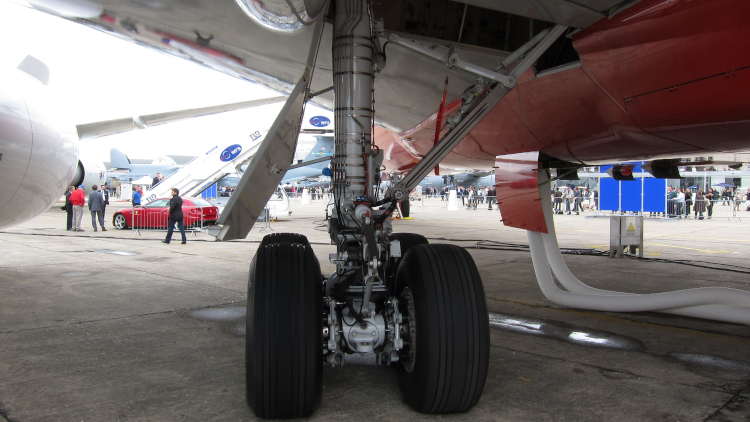3 claims - each wrong
and ....
Reynolds number similarity is big issue eg for airliner work (that's not an issue for F1)
3 claims - each wrong
all 3 claims 100% correctTommy Cookers wrote: ↑20 Dec 2020, 14:453 claims - each wrong
and ....
Reynolds number similarity is big issue eg for airliner work (that's not an issue for F1)

You’re entirely missing the point. 18 posts in... not a good look for you here.Uwe wrote: ↑20 Dec 2020, 15:52all 3 claims 100% correctTommy Cookers wrote: ↑20 Dec 2020, 14:453 claims - each wrong
and ....
Reynolds number similarity is big issue eg for airliner work (that's not an issue for F1)
Where do you see aerodynamics influence at gear?not even airfoil shape anywhere!
Totaly negleceted in aerodanynamics sense!
https://insights.globalspec.com/images/ ... ype-hl.png
once again,aviation dont care about gear aerodynamics..endHoffman900 wrote: ↑20 Dec 2020, 17:33You’re entirely missing the point. 18 posts in... not a good look for you here.Uwe wrote: ↑20 Dec 2020, 15:52all 3 claims 100% correctTommy Cookers wrote: ↑20 Dec 2020, 14:45
3 claims - each wrong
and ....
Reynolds number similarity is big issue eg for airliner work (that's not an issue for F1)
Where do you see aerodynamics influence at gear?not even airfoil shape anywhere!
Totaly negleceted in aerodanynamics sense!
https://insights.globalspec.com/images/ ... ype-hl.png
Uwe wrote: ↑20 Dec 2020, 18:00once again,aviation dont care about gear aerodynamics..endHoffman900 wrote: ↑20 Dec 2020, 17:33You’re entirely missing the point. 18 posts in... not a good look for you here.Uwe wrote: ↑20 Dec 2020, 15:52
all 3 claims 100% correct
Where do you see aerodynamics influence at gear?not even airfoil shape anywhere!
Totaly negleceted in aerodanynamics sense!
https://insights.globalspec.com/images/ ... ype-hl.png
Why do you think all the time that speed increase complexity??????Hoffman900 wrote: ↑20 Dec 2020, 18:06Uwe wrote: ↑20 Dec 2020, 18:00once again,aviation dont care about gear aerodynamics..endHoffman900 wrote: ↑20 Dec 2020, 17:33
You’re entirely missing the point. 18 posts in... not a good look for you here.
at speeds well north of a F1 car,
A plane has all of those things, but unlike a F1 car, they impact the control surface, and the aero sweet spot has to be good over a HUGE speed range, with different air densities, and winds that could reach a hundred miles per hour or more, and winds from all directions.Uwe wrote: ↑20 Dec 2020, 18:11Why do you think all the time that speed increase complexity??????
separted flow and turbulance make complexity, not speed..
I think having to let go of the assumption that air is incompressible makes calculations more complicated. Isn't it normally assumed that it is OK to assume constant air density all the way to about 300 Km/h but not beyond?

Hoffman900 wrote: ↑20 Dec 2020, 02:52I really don't know if I would be confident enough to fly in a plane designed by Ferrari's aero department

Hey I know this one. Think I watched it in one of curious droid's vids.Hoffman900 wrote: ↑20 Dec 2020, 02:52There is a famous crash of the XB-70 in 1966 where a F-104 got sucked into the wing tip wake vortex and crashed into it.
This is what makes engine CFD hard to do really well. A port could see .6 mach (.7 for a really fast one) average in the intake tract at peak (negative velocity near the valve opening and closing), you have pressure waves moving back and forth, fuel and port temperatures changing density, flow is not laminar, reynolds numbers come into play, etc, and it's all happening really fast.
Simply put, it's a case of "shît in, shît out".Uwe wrote: ↑19 Dec 2020, 18:37How accurate is our "cheap" CFD ,I am talking about ours personal computer power..not super comupters from F1,Boeing,NASA,American cup,car industry etc...
Can we rely on this data and how much men who working with CFD can make wrong job?
Does results form CFD depend on men knowledge about aerodynamics and CFD-job or this is just depend at softwear and computer power?
Absolutely agree - you can have the best of everything around you, but if you don't know how to really extract the most out of what you need, then you will not be able to get decent results out of it. Just ask some of my colleagues who I train up!!wesley123 wrote: ↑19 Dec 2020, 20:26The tool only is as good as the person using it. If you use it and have no clue what you are actually doing, it won't yield desirable results.
I think a home computer(albeit a high-end one) is very much capable of doing CFD, and providing correct results. However, you'll have to do concessions on the detail of the model.
jjn9128 wrote:
See above, but <1% is very much attainable. Most teams are able to match their CFD to wind tunnel pretty much bang on, and same with track -- though sometimes a constant delta to drag might be applied, but that delta is very well understood and allows for very good predictions to be made regardless.Hoffman900 wrote: ↑19 Dec 2020, 23:09That seems optimistic. 1% is for what kind of design? A glider or a F1 car? How do you know what 1% is if you have nothing to go off of?
From an engineering side, just throwing a general value of 1% out there is kind of reckless without qualifying it.
So... This is kinda an interesting one... Because the two are mutually opposed in what their "goals" are.
Landing gear actually is a huge thing that has to be CFD'd. In fact, LES is used almost exclusively for landing gear simulation due to how much dirty air is thrown off of those things. Again, the goal of aircraft is to minimise drag, and so folding up the landing gear is a no brainer to do that. But when you have to deploy it to land, the vibration from vortex shedding and drag increase is huge - but it is only used for a short amount of time. And so if they were to shroud it, sure... it would be less draggy... but you have to remember that for 90+% of the flight time, they would be carrying the excess weight of that shroud in cruise -- which means more lift produced, so more drag, so less efficient overall. I can assure you that those calculations do happen. Even down to why planes are painted white -- the paint has less pigment in it, and so it is lighter. You could be forgiven for assuming that polishing the aluminium without paint is best, but the maintenance cost of that (having to wash it and keep it polished so it doesn't corrode) vs. the extra fuel that the plane burns by carrying the white paint weight makes it not worthwhile.
For the most part, around 0.3 Mach, air only has ~1-2% compressibility. But up around 0.7 Mach, that increases to ~10%. Compressibility is technically "harder", since its another thing to solve for, but where the tricky bit comes in is where there is local flow acceleration over a wing, whilst travelling at transonic speeds, and then that acceleration bridges the final 0.1 - 0.2 Mach to make it supersonic, and then create a shock front on the wing's surface... that is baaaaaaaaad. And its actually why a lot of airliners use quite a high degree of wing sweep. The sweep means that air closer to the fuselage hits the leading edge stagnation first, and so that creates a higher pressure, which bleeds out to the tips (where the air isn't stagnating yet) and pushes the flow slightly towards the wingtip.
(so-called) low-speed wind tunnels are where the real work is doneUwe wrote: ↑20 Dec 2020, 15:52all 3 claims 100% correctTommy Cookers wrote: ↑20 Dec 2020, 14:453 claims - each wrong
and .... Reynolds number similarity is big issue eg for airliner work (that's not an issue for F1)